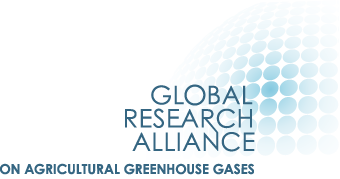Keywords: Expert judgement | interpolation | digestibility | methane conversion rates
What data needs were addressed? An estimate of digestible energy (DE as a % of GE [MJ/Day]) was required for feedlot cattle.
Why was the data needed? Diet composition for feedlot cattle in the USA has been changing rapidly as feedlots change their practices based on new nutritional information and changing feed availability. Therefore, values for DE and Ym in the USA’s GHG inventory are adjusted over time.
Methods used: interpolation of available data, expert surveys, expert opinion, modeling.
How was the data gap addressed? Feedlot diets are assumed to not differ significantly by region within the country, so a single set of national diet values is used each year.
For 1990, DE and Ym values used in the inventory were provided by a leading academic on methane production in cattle.
For 1991-1999, values were linearly extrapolated based on values for 1990 and 2000.
For 2000 onwards, values for Ym were estimated using the MOLLY model, as described in Kebreab et al. (2008). This model is a dynamic mechanistic model of nutrient utilization in cattle. Methane production is predicted based on hydrogen balance. Excess hydrogen produced during fermentation of carbohydrates and protein to lipogenic VFA (acetate and butyrate) is partitioned between use for microbial growth, biohydrogenation of unsaturated fatty acids, and production of glucogenic VFA (propionate and valerate). It is assumed that the remaining hydrogen is used for methanogenesis.
To run the MOLLY model, data on average diet feed compositions was taken from Galyean and Gleghorn (2001) for 2000 through 2006 and Vasconcelos and Galyean (2007) for 2007 onwards. These sources are an annual survey of consulting animal nutritionists. The survey is a postal or web-based survey, with respondent numbers generally between 19 and 31. The questionnaire asks the nutritionists to indicate, among other things:
- the % of dry matter contributed by different types of grain, grain by-products, roughage and other supplements to the cattle finishing diet,
- the recommended concentration of key nutrients in the diet for cattle at different growth stages,
- other management practices recommended to feedlots (e.g. diet adjustment periods).
DE values and other parameters required as inputs to the MOLLY model are estimated from the survey responses. For example, in 2015, feedlot cattle DE was estimated at 82.5, and a Ym value predicted at 3.9%.
The methods used to estimate DE and Ym for other types of cattle in the USA differ from the methods summarized here and are described in the annexes to USA NIR 2017.
Further Resources
Galyean ML, Leghorn JF. 2001. Summary of the 2000 Texas Tech University Consulting Nutritionist Survey. Texas Tech University.
Kebreab E et al. 2008. Model for estimating enteric methane emissions from United States dairy and feedlot cattle. Journal of animal science.
Vasconcelos JT, Galyean ML. 2007. Nutritional recommendations of feedlot consulting nutritionists: The 2007 Texas Tech University Study. Journal of Animal Science.
Author: Andreas Wilkes, Values for development Ltd (2019)

